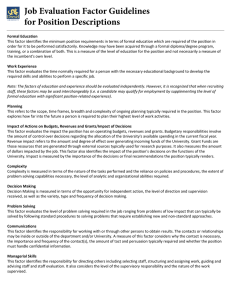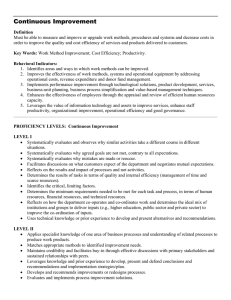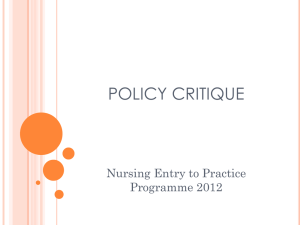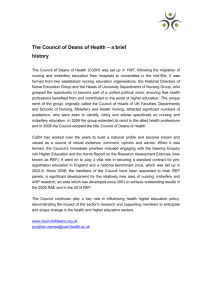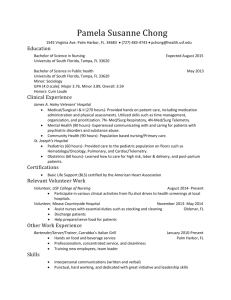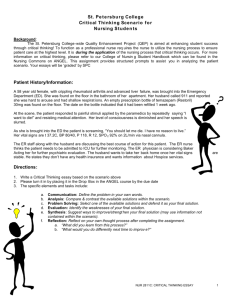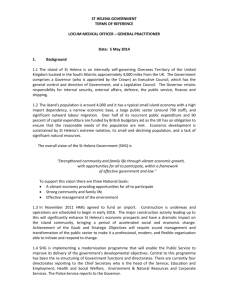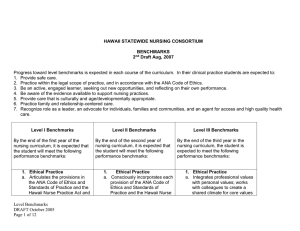Problem solving - Assuring Graduate Capabilities
advertisement
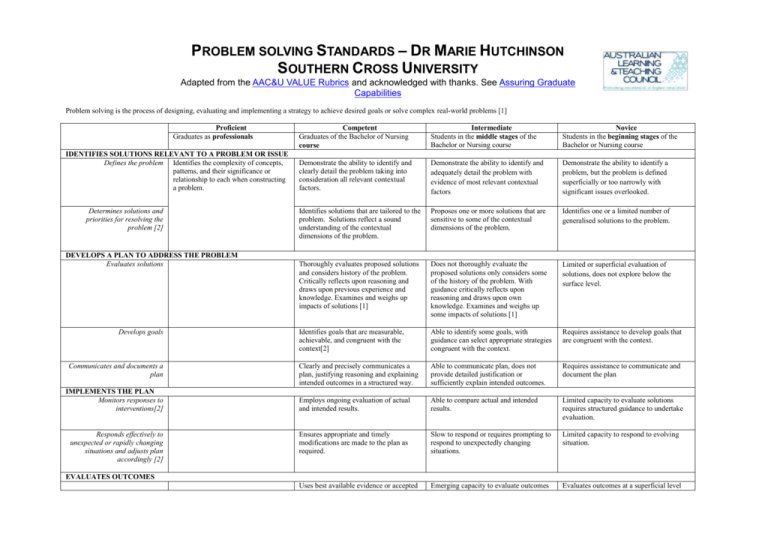
PROBLEM SOLVING STANDARDS – DR MARIE HUTCHINSON SOUTHERN CROSS UNIVERSITY Adapted from the AAC&U VALUE Rubrics and acknowledged with thanks. See Assuring Graduate Capabilities Problem solving is the process of designing, evaluating and implementing a strategy to achieve desired goals or solve complex real-world problems [1] Proficient Graduates as professionals IDENTIFIES SOLUTIONS RELEVANT TO A PROBLEM OR ISSUE Defines the problem Identifies the complexity of concepts, patterns, and their significance or relationship to each when constructing a problem. Determines solutions and priorities for resolving the problem [2] DEVELOPS A PLAN TO ADDRESS THE PROBLEM Evaluates solutions Develops goals Communicates and documents a plan IMPLEMENTS THE PLAN Monitors responses to interventions[2] Responds effectively to unexpected or rapidly changing situations and adjusts plan accordingly [2] Competent Graduates of the Bachelor of Nursing course Intermediate Students in the middle stages of the Bachelor or Nursing course Novice Students in the beginning stages of the Bachelor or Nursing course Demonstrate the ability to identify and clearly detail the problem taking into consideration all relevant contextual factors. Demonstrate the ability to identify and adequately detail the problem with evidence of most relevant contextual factors Demonstrate the ability to identify a problem, but the problem is defined superficially or too narrowly with significant issues overlooked. Identifies solutions that are tailored to the problem. Solutions reflect a sound understanding of the contextual dimensions of the problem. Proposes one or more solutions that are sensitive to some of the contextual dimensions of the problem. Identifies one or a limited number of generalised solutions to the problem. Thoroughly evaluates proposed solutions and considers history of the problem. Critically reflects upon reasoning and draws upon previous experience and knowledge. Examines and weighs up impacts of solutions [1] Does not thoroughly evaluate the proposed solutions only considers some of the history of the problem. With guidance critically reflects upon reasoning and draws upon own knowledge. Examines and weighs up some impacts of solutions [1] Limited or superficial evaluation of solutions, does not explore below the surface level. Identifies goals that are measurable, achievable, and congruent with the context[2] Able to identify some goals, with guidance can select appropriate strategies congruent with the context. Requires assistance to develop goals that are congruent with the context. Clearly and precisely communicates a plan, justifying reasoning and explaining intended outcomes in a structured way. Able to communicate plan, does not provide detailed justification or sufficiently explain intended outcomes. Requires assistance to communicate and document the plan Employs ongoing evaluation of actual and intended results. Able to compare actual and intended results. Limited capacity to evaluate solutions requires structured guidance to undertake evaluation. Ensures appropriate and timely modifications are made to the plan as required. Slow to respond or requires prompting to respond to unexpectedly changing situations. Limited capacity to respond to evolving situation. Uses best available evidence or accepted Emerging capacity to evaluate outcomes Evaluates outcomes at a superficial level EVALUATES OUTCOMES standards to come to well-considered conclusions about outcomes [3-4] 1. 2. 3. 4. using available evidence or accepted standards. without reference to available evidence or accepted standards. Association of American Colleges and Universities AAC&U Value Rubrics. Australian Nursing and Midwifery Council Limited (ANMC), National competency standards for the registered nurse. 2005, Australian Nursing and Midwifery Accreditation Council Limited: Dickson, ACT. Paul, R. and L. Elder, Consequential validity: Using assessment to drive instruction, in W h i te Pa p e r, F.f.C. Thinking, Editor. 2002: www.criticalthinking.org. Facione, N.C. and P.A. Facione, eds. Critical Thinking and Clinical Judgment. Clinical Reasoning in the Health Sciences: A Teaching Anthology. 2008, Insight Assessment. The California Academic Press: Millbrae CA. 1-13.
